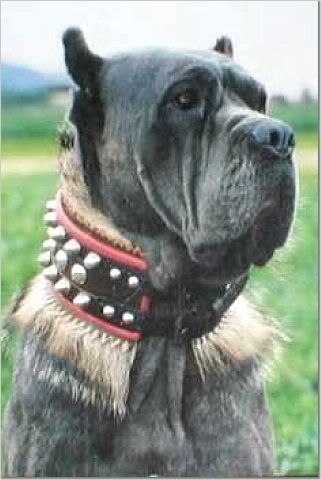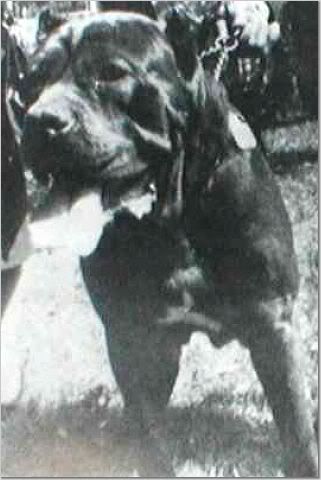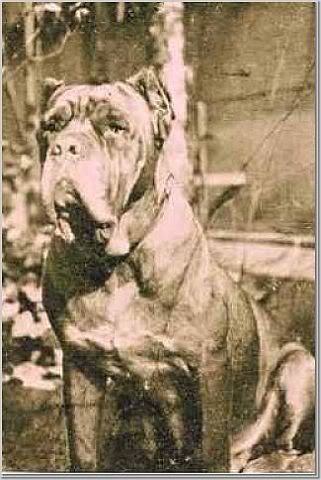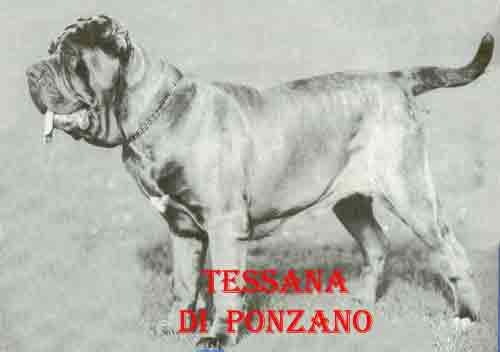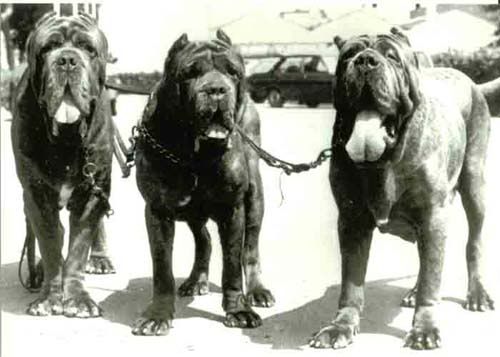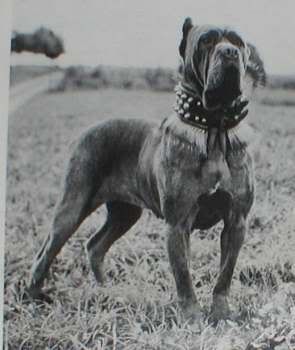Παραθετω ενα κειμενο που λεει αρκετα πραγματα για την ιστορια της συγκεκριμενης φυλης.....ειναι ομως στα Αγγλικα....ελπιζω να βρω χρονο να κανω τη μεταφραση καποια στιγμη και να το βαλω και στα Ελληνικα!
Neapolitan mastiff, Mastino Napoletano, and original Il Mastino Napoletano, is the dog at least changed since ancient times. Dogs fighting such a vein at least five thousand years ago. Mastino seems to be alive if it moved from earliest antiquity, looking like a true copy of the archaic Sumerian dog fighting.
A large number of excavations of ancient Mesopotamia, the area shows the existence in that area and time of huge dogs Molos type, that look like today's Neapolitan mastiff. These excavations provide a monstrously huge dogs big heads, short kufami, podgardlami drooping, wrinkled muzzles, cut ears and massive feet.
About 3300r. BC The Sumerians were among the first to use the large Molossians battle to fight and hunt, which is confirmed by clay tablets found from that period. in the second millennium BC Sumerian civilization was overrun by the other belligerent nations, among which was dominated by Akadowie. Mesopotamia area then began to be known as Babylonia. From this period comes it found a statue depicting Babylon in the type of dog fighting Mastino. With the advent of the first millennium BC The Assyrians conquered the ancient land of Mesopotamia and Babylonia, from which the period found in Nineveh thumbnail terakotowego dog, which was written his name - hunter enemies.
Dogs shown on the Assyrian paintings, terracotta figurines płaskorzeźbachi ancestors were Molossians that Alexander the Great brought with him from his conquest of the Middle East and western Asia in the fourth century BC Mastino were szczute various wild animals, including lions, tigers and even elephants in performances arranged by the Alexander and his subordinates. Alexander led the conquests continued in order to acquire funds that would make it even more powerful. Great, looking terribly Mastino were therefore not only a tool of struggle and entertainment at the Olympics, but a symbol of social status and power. When, after the death of Alexander the Great's empire broke up, the great Macedonian Molossian were taken over by the Romans.
The Romans engaged in constant war, and therefore still need a robust security for their families and homes during long military campaigns. When the father of the family, wyruszający the military expedition, left the house to guard dangerous mastiff, he could feel calm and confident that his family and work are in safe and reliable "hands." In those conditions, followed - in accordance with the demand - development and improvement of the Roman guard dog.
When the Roman Empire disintegrated, and the nations of Europe have begun to organize their territories into separate countries, the descendants of Roman Molossians evolved into different varieties of modern mastiffs. Each "race" has received a name and description of the country in whose territory is found. So we now have an English mastiff, dog de bordeaux french, spanish mastiff, Saint Bernard Swiss or German Rottweiler.
However, it is the Mastino Napoletano is the one that has remained virtually the same as those described by Columella at the time of the Roman Empire. It survived for centuries, like the Colosseum, tradition, history and other remains of a mighty empire, which was ancient Rome. It looks like most of all the antiquity of modern mastiffs.
The advent of the Middle Ages brought attitude to the other dog in general, and in particular the Mastino Napoletano. The reason was mainly Germanic superstition connected with the new mentality of the people of Christian Europe. In some societies, there was even that began to fear and hate Mastino, and identified him from all evil and infernal powers, this attitude still survived to modern times.
In the area of Naples and Mount Vesuvius area adjacent to the Mastino stored, and propagated for centuries. They were highly appreciated by both the rich landowners and the poorer the farmers. They were not sold officially, but only cultured and were distributed in closed circles and among friends. For this reason, not been drawn up any official documents, genealogies, etc., and therefore there are no records of breeding lines, breeders or unique copies.
Mastino Napoletano become an officially recognized breed
Shortly after the Second World War a small group of enthusiasts from the area of Naples, began to gather any data on any living molosach, hoping to revive the Mastino Napoletano and present it to worlds in the form of officially recognized rasy.Nie was an easy task ruins of the country. Number of copies to have survived a war hell, it was small, and those that have survived, were very diverse in type and burdened with various genetic defects caused by years of neglect and propagation in the near imbredzie. "Collection", which managed to bring together, was shown at the dog show in Naples in 1946, the show did not cause the expected sensation, but it attracted the attention of well-known Italian writer, journalist and lover of dogs Scanzianiego Pier, which has now decided to fight for saved from extinction "race", which is part of Italian history, traditions and heritage. Helped him in that Dr. Ruggero Soldati and other lovers of old Molossians.
From the very beginning of the reconstruction of the breed were divided among the creators of opinions as to its future, its official name. Ultimately, the name of Il Mastino Napoletano won.
In 1949, Scanziani shown at an exhibition in Naples dog named Guaglione, who later became the first official race champion Mastino Napoletano.
Breeders of the Italian South, which was the home of Mastino, for centuries, they wanted to see him above all a strong guard dog. They had no aspirations of "producing" a dog exhibition, in their view, Mastino Napoletano, should be powerful, massive and heavy, rather low set and deal with the protection of people and their property. This variety, or rather the breeding line, is known as "Zacarro", from the name of the breeder, whose family had this type of dogs, bred for many generations. Another approach had the keeper of the North of Italy. Mastino they saw as the more universal the dog, which could be at the exhibitions to popularize dog rasowych.Najbardziej known reprezentanten such thinking was Marco Quercia - a businessman from the region have kept Florencji.Querci Mastino Napoletano since the early 50s, until his death in 1990.
In 1958 he won the first championship for his dog named Shaib first At the end of that year, "produced" their first bitch Champion - Susie and Ian since 1963 to register their dogs with the nickname Di Ponzano, occurring after today in the pedigrees of the most famous Mastino in the world.

Neapolitan mastiff, Mastino Napoletano, and original Il Mastino Napoletano, is the dog at least changed since ancient times. Dogs fighting such a vein at least five thousand years ago. Mastino seems to be alive if it moved from earliest antiquity, looking like a true copy of the archaic Sumerian dog fighting.
A large number of excavations of ancient Mesopotamia, the area shows the existence in that area and time of huge dogs Molos type, that look like today's Neapolitan mastiff. These excavations provide a monstrously huge dogs big heads, short kufami, podgardlami drooping, wrinkled muzzles, cut ears and massive feet.
About 3300r. BC The Sumerians were among the first to use the large Molossians battle to fight and hunt, which is confirmed by clay tablets found from that period. in the second millennium BC Sumerian civilization was overrun by the other belligerent nations, among which was dominated by Akadowie. Mesopotamia area then began to be known as Babylonia. From this period comes it found a statue depicting Babylon in the type of dog fighting Mastino. With the advent of the first millennium BC The Assyrians conquered the ancient land of Mesopotamia and Babylonia, from which the period found in Nineveh thumbnail terakotowego dog, which was written his name - hunter enemies.
Dogs shown on the Assyrian paintings, terracotta figurines płaskorzeźbachi ancestors were Molossians that Alexander the Great brought with him from his conquest of the Middle East and western Asia in the fourth century BC Mastino were szczute various wild animals, including lions, tigers and even elephants in performances arranged by the Alexander and his subordinates. Alexander led the conquests continued in order to acquire funds that would make it even more powerful. Great, looking terribly Mastino were therefore not only a tool of struggle and entertainment at the Olympics, but a symbol of social status and power. When, after the death of Alexander the Great's empire broke up, the great Macedonian Molossian were taken over by the Romans.
The Romans engaged in constant war, and therefore still need a robust security for their families and homes during long military campaigns. When the father of the family, wyruszający the military expedition, left the house to guard dangerous mastiff, he could feel calm and confident that his family and work are in safe and reliable "hands." In those conditions, followed - in accordance with the demand - development and improvement of the Roman guard dog.
When the Roman Empire disintegrated, and the nations of Europe have begun to organize their territories into separate countries, the descendants of Roman Molossians evolved into different varieties of modern mastiffs. Each "race" has received a name and description of the country in whose territory is found. So we now have an English mastiff, dog de bordeaux french, spanish mastiff, Saint Bernard Swiss or German Rottweiler.
However, it is the Mastino Napoletano is the one that has remained virtually the same as those described by Columella at the time of the Roman Empire. It survived for centuries, like the Colosseum, tradition, history and other remains of a mighty empire, which was ancient Rome. It looks like most of all the antiquity of modern mastiffs.
The advent of the Middle Ages brought attitude to the other dog in general, and in particular the Mastino Napoletano. The reason was mainly Germanic superstition connected with the new mentality of the people of Christian Europe. In some societies, there was even that began to fear and hate Mastino, and identified him from all evil and infernal powers, this attitude still survived to modern times.
In the area of Naples and Mount Vesuvius area adjacent to the Mastino stored, and propagated for centuries. They were highly appreciated by both the rich landowners and the poorer the farmers. They were not sold officially, but only cultured and were distributed in closed circles and among friends. For this reason, not been drawn up any official documents, genealogies, etc., and therefore there are no records of breeding lines, breeders or unique copies.
Mastino Napoletano become an officially recognized breed
Shortly after the Second World War a small group of enthusiasts from the area of Naples, began to gather any data on any living molosach, hoping to revive the Mastino Napoletano and present it to worlds in the form of officially recognized rasy.Nie was an easy task ruins of the country. Number of copies to have survived a war hell, it was small, and those that have survived, were very diverse in type and burdened with various genetic defects caused by years of neglect and propagation in the near imbredzie. "Collection", which managed to bring together, was shown at the dog show in Naples in 1946, the show did not cause the expected sensation, but it attracted the attention of well-known Italian writer, journalist and lover of dogs Scanzianiego Pier, which has now decided to fight for saved from extinction "race", which is part of Italian history, traditions and heritage. Helped him in that Dr. Ruggero Soldati and other lovers of old Molossians.
From the very beginning of the reconstruction of the breed were divided among the creators of opinions as to its future, its official name. Ultimately, the name of Il Mastino Napoletano won.
In 1949, Scanziani shown at an exhibition in Naples dog named Guaglione, who later became the first official race champion Mastino Napoletano.
Breeders of the Italian South, which was the home of Mastino, for centuries, they wanted to see him above all a strong guard dog. They had no aspirations of "producing" a dog exhibition, in their view, Mastino Napoletano, should be powerful, massive and heavy, rather low set and deal with the protection of people and their property. This variety, or rather the breeding line, is known as "Zacarro", from the name of the breeder, whose family had this type of dogs, bred for many generations. Another approach had the keeper of the North of Italy. Mastino they saw as the more universal the dog, which could be at the exhibitions to popularize dog rasowych.Najbardziej known reprezentanten such thinking was Marco Quercia - a businessman from the region have kept Florencji.Querci Mastino Napoletano since the early 50s, until his death in 1990.
In 1958 he won the first championship for his dog named Shaib first At the end of that year, "produced" their first bitch Champion - Susie and Ian since 1963 to register their dogs with the nickname Di Ponzano, occurring after today in the pedigrees of the most famous Mastino in the world.

Last edited by a moderator:

